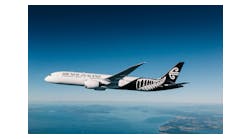Sept. 09--Boeing's 787 Dreamliner, the revolutionary but trouble-plagued new generation jet liner may not be fulfilling the company's promises for reliable operations, but it is fulfilling Boeing's prophecy of opening up new cities to international flights.
As the 787 enters the fleets of airlines around the world, those airlines are using the plane's long reach and lower operating costs to create new connections between cities around the globe.
Those new connections come in spite of the Dreamliner's spotty record of availability due to battery and electrical connection issues.
British Airways last week, for instance, announced a new non-stop flight between London and Austin, Tex. beginning in March. The flight will be Austin's first non-stop flight to a destination outside North America.
United Airlines also said it will use a 787 to open a route between China's fourth-largest city, Chengdu, and San Francisco beginning in June. No longer will travelers to that urban area of 14 million people in Western China have to change planes at Asian hubs such as Beijing, Shanghai or Tokyo.
The 787-8, with a capacity of some 230 passengers and a cost per seat mile about 20 percent less than previous generation aircraft, offers airlines a cost-effective way to open up what Boeing calls "long-thin" markets whose passenger traffic was too little for the large 747s and 777s. Those city pairs in some cases were too distant for mid-sized aircraft such as Boeing 767 to reach non-stop.
In addition to lower costs, the 787's range of more than 8,000 miles surpasses that of the 767, whose maximum range was a little more than 6,600 miles non-stop.
That extended range allows United Airlines to fly the 787 the 6,512 miles between Houston and Lagos, Nigeria reliably without stopping for fuel. The Dreamliner's range also enables United to connect Chengdu and San Francisco, which are some 7,000 miles distant from one another.
The moderate seating capacity of the Dreamliner also gives airlines a tool to open new markets in which they couldn't fill a 350-seat 777 or a 420-seat 747.
Japan Airlines, for instance, is using a 787 on new routes between Boston and Tokyo and San Diego and Tokyo. Those connections weren't economically doable with a larger aircraft.
In the Puget Sound area, All Nippon Airways, used a Dreamliner to establish itself in the busy Sea-Tac-Tokyo market in competition with entrenched competitors, United and Delta. ANA is also flying a Dreamliner between San Jose in California and Tokyo, the first Asian non-stop in years for that Bay area city.
With the proliferation of flights between Sea-Tac and Tokyo in recent months, United plans to introduce a Dreamliner on the route this fall to better fit its market share on a route that on some days of the week has four non-stop flights to the Japanese capital.
The Dreamliner is also allowing new entrants to enter foreign markets. Low-fare carrier Norwegian Air Shuttle plans to use its growing fleet of 787s to connect Scandivian cities such as Oslo, Stockholm and Copenhagen with the U.S. cities of Los Angeles and Oakland beginning next year.
The Dreamliner's range is opening up markets from mid-continent hubs to overseas cities.
United is employing a Dreamliner to connect its big Denver hub with Tokyo.
Copyright 2013 - The News Tribune (Tacoma, Wash.)





